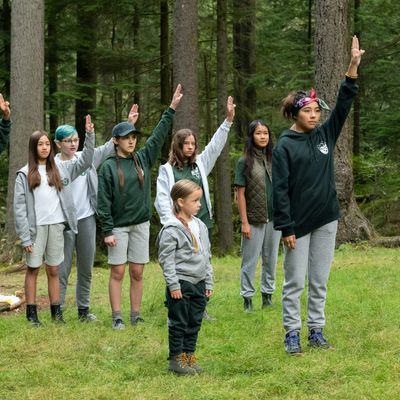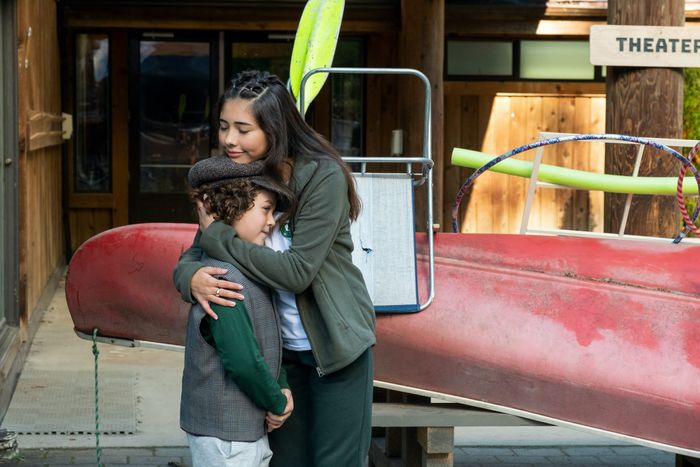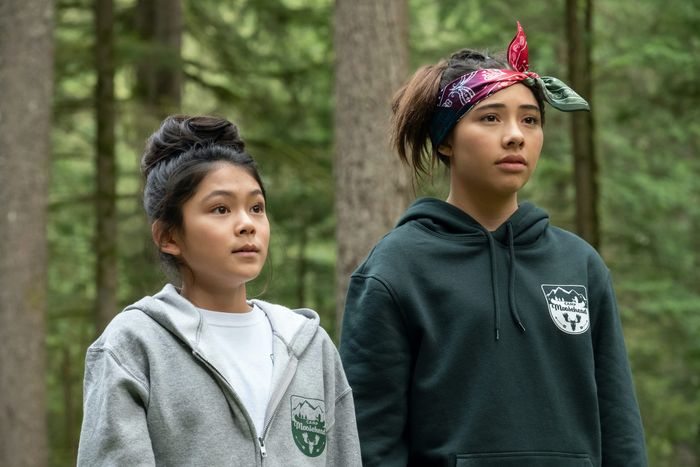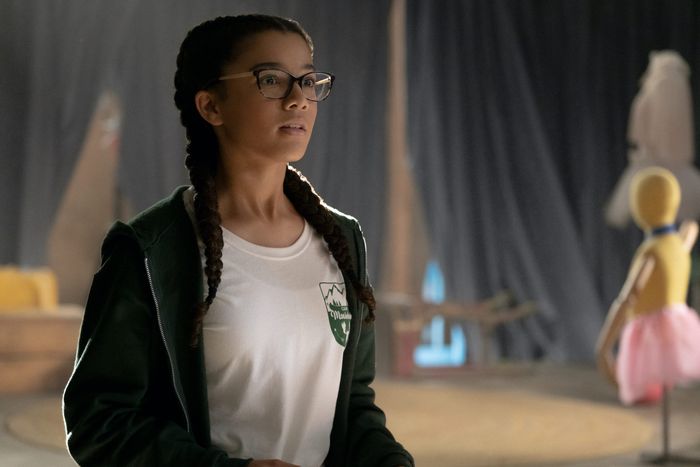
Like many kids who started reading chapter books in the mid-1990s, I picked up a lot of surprisingly practical knowledge from Ann M. Martin’s The Baby-Sitters Club. I learned from Mallory that dyeing your hair blonde on a beach-vacation whim can turn out disastrously and from Stacey that it can be pretty easily reversed. I learned from Dawn’s stepdad, Richard, that “hospital corners” are the ultimate sign of a neat and carefully made bed, and decades later, I still think of him every time I crease a bedsheet (or just can’t muster the energy to crease a bedsheet) before tucking it under my mattress.
Earlier this month, Netflix’s delightfully updated adaptation of The Baby-Sitters Club introduced a new generation of young people to the franchise and its useful lessons. The last two episodes — the episodes that draw the least from Martin’s source material — find the BSC at summer camp, where Dawn Schafer (Xochitl Gomez) organizes a protest after she and Claudia Kishi (Momona Tamada) discover just how many more opportunities the camp offers to kids whose parents can provide them with extra cash. In the season finale, Dawn explains to an older counselor that protests are a form of civil disobedience, builds a makeshift barricade out of old cabin furniture, and then warns her fellow protesters that the camp director has probably gone out to recruit reinforcements to quash their rally.
Damn, I thought, watching all this unfold. For some kid out there somewhere, the lesson they’ll forever trace back to The Baby-Sitters Club is to always be prepared for hostile authorities to send in reinforcements.
In the 1980s and ’90s, sitcoms aimed at teenage and preteen audiences gained a reputation for dealing with the ripped-from-the-headlines issues affecting young people at the time — like drug abuse, teen pregnancy, and drunk driving — in hokey, ham-handed special episodes. What often lent these special episodes their characteristic corniness was the conspicuous absence of the humor that viewers tuned in for in the first place. But The Baby-Sitters Club, a throwback of sorts to the golden age of kids’ sitcoms like Boy Meets World, Full House, and Saved by the Bell, pulls off a rare feat with its two episodes about inequality, social justice, and civic engagement: the educational, topical storyline that doesn’t feel uncharacteristically somber or didactic. “Hello, Camp Moosehead! Parts 1 and 2” are two genuinely special episodes that never veer into Very Special Episode territory, and according to the writers, that’s partly because they didn’t set out to write an episode about social justice. Rather, they set out to create characters who speak, think, and act like the socially conscious preteens of today and then built storylines around what they believed would be their characters’ natural instincts.
In both the original books and in the Netflix adaptation, several of the titular babysitters’ character arcs are defined by timeless preteen problems: divorce and blended families, hormonal overdrive, and the imposing shadow of overachieving older siblings, to name a few. But Dawn in particular, who is Latinx and has a gay dad in the TV series (she was white and had two straight parents in the books), struck executive producer Lucia Aniello as “a character who’s really of the moment” — and a character who, if she were alive in the world today, would likely have some experience with injustice and with standing up against it through civil disobedience.
“I feel like [she’s] actually, more than ever, a type of kid that exists, based on circumstances,” Aniello said. “More and more, social media is making kids understand that this is what they have to do to create a world they want to live in.” Just weeks before The Baby-Sitters Club premiered on Netflix, teenage activists organized rallies and marches across the United States after George Floyd was murdered by police in Minnesota. As Aniello was writing Dawn and developing the show, she also thought about Emma González, who survived the 2018 shooting at Marjory Stoneman Douglas High School when she was 18 and then became a gun-control activist.
Dawn, in the original books, is an environmentalist and a health-food enthusiast, so the writers asked themselves: What’s the 2020 equivalent of a hyperprogressive, globally conscious ’90s kid? “There had been discussions the whole season long about how this new iteration of Dawn could be very into social justice. That felt really true, [given] who Dawn has always been in the books, to who she would be now,” said Ariel Karlin, who co-wrote the finale with Aniello. Earlier episodes in the series had found the babysitters standing up for the rights of oppressed people; in one storyline, Mary Anne (Malia Baker) overcomes her shyness to stand up for a transgender child in her care who’s been misgendered by a doctor. But as the writers sat down to map out the end of the season, “there hadn’t been this sort of social justice, protest moment yet,” Karlin said. The “Hello, Camp Moosehead!” episodes seemed like an auspicious place to put one.
For viewers, it helps that it’s Dawn, a character revealed over the course of eight previous episodes to be informed, empathetic, and outspoken, who introduces a plotline that deals with the currently red-hot topic of civil disobedience. The arc seems logical, rather than shoehorned in, dodging a common problem of Very Special Episodes. It helped the writers, too: As they began building out the two episodes’ subplots, having a central plot that felt organic to Dawn made it easier to imagine the other characters’ responses — and those responses give the episodes some of their most powerful scenes.
Claudia, who is shown throughout the season to have a big heart and perhaps a somewhat less big vocabulary, tells Dawn that she thinks it’s unfair that some activities are off-limits to the kids whose families can’t afford to pay extra for them. But she looks a little lost when Dawn declares the phenomenon “socioeconomic stratification.” “You’re … agreeing with me, right?” Claudia asks. “Absolutely!” Dawn responds warmly. In their subsequent conversations, Dawn continues to describe the camp’s inequality problem with a sophisticated social-justice vocabulary, while Claudia continues to describe it in plain, preteen English. Young viewers, as a result, are exposed to both the grown-up phrases for these concepts and their kid-friendly definitions.
The scenes between Claudia and Dawn also serve as effective examples of how to meet people where they are, so to speak, in activism contexts. “It’s not a barrier for Claudia that Dawn is using these words that she doesn’t understand, and it’s not a barrier for Dawn that Claudia doesn’t have that same vocabulary,” Karlin said. “They just know that they both have good values, and they’re able to get on the same page.”
“It’s such a good lesson about not shaming each other as we all go into this new phase of life where we actually can learn and change and be better,” Aniello agreed.
Mary Anne, meanwhile, who spends the Camp Moosehead episodes throwing herself headfirst into directing the camp musical, initially feels annoyed at Dawn’s activist efforts. Her cast members abruptly ditch their final dress rehearsal when Dawn compels campers to go on strike from their activities. (“Sorry, Mary Anne. I’m a union guy,” one tiny boy in costume says sadly as he exits.) Later, the noise from Dawn’s protest derails the musical’s premiere.
Eventually, after a heartfelt conversation, Mary Anne gets on board and supports Dawn’s efforts by offering tired demonstrators seats in the theater, where they can watch the performance while they rest up. But the writers liked the brief tension of Dawn’s protest colliding with Mary Anne’s musical. For one thing, it allowed the show to examine more angles on the issue than simply “protesting is good” and “protesting is bad.” “There are different sides, and we can explore them all while the message behind the episode is still, obviously, how awesome it is that they’re doing this,” said Joanna Calo, who wrote “Hello, Camp Moosehead! Part 1”. Mary Anne’s storyline illustrates that there’s also a “protesting sometimes requires big sacrifices” side and a “protesting isn’t the only way to support social movements” side of the story, too.
Ultimately, Aniello said, the secret to writing a timely, politically relevant — but entertaining — episode of kid-friendly TV is to think carefully and realistically about how real people would respond to the situation at hand. “As long as you’re really committing to [portraying] how each character would react, you can avoid the trappings of that kind of ‘after-school special’ stuff,” she said. Where so many topical episodes fail, she added, is in their portrayals of issues like eating disorders and physical abuse as black or white; too often, they place characters squarely on the wrong and right sides of an issue, with little attention to nuance. Kids often have a better grasp on the complexity of interpersonal situations than the creators of children’s entertainment give them credit for, but The Baby-Sitters Club managed to take kids seriously as an audience by taking kids seriously as characters. “We tried to show how everybody feels about these situations. Some people are living in the gray areas,” Aniello said. “I think that makes it feel more real.”




